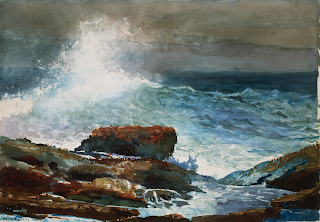Initial Notes: Technically, this house is connected to the Portland Museum of Art, but I consider it a separate entity because of the wealth of history it holds within itself. It is a beautiful three floor mansion that was donated to the Museum (we'll get into that more in the reaction part). Every time I go to the museum this is one of my favorite things to check out even though it does not really change at all. The architecture of the building is just so grand and different that I love walking around it. I especially love the, I guess you could call it, floating stair case in the entrance.
Reaction: In 1908, Mrs. Margaret Jane Mussey Sweat donated her three story mansion, the McLellan House, and money to the Portland Museum of Art to create a gallery in honor of her late husband, Lorenzo de Medici Sweat. The galleries within the mansion were designed by architect, John Calvin Stevens, and it opened to the public in 1911.
Post-Revolution Maine
was an interesting place to be. The McLellan House is a product of this time in
Maine’s history. The economy was given a boost and because of this Maine’s
coastal towns and cities were booming and they used architectural means to show
their social status, which explains why the McLellan House is so grand. These houses
became symbols of people’s power and their status in the growing economy. The McLellan
House was originally designed by architect, John Kimball Senior. It was
designed for one of Portland’s shipping tycoons, Major Hugh McLellan. The house
was considered one of Kimball’s biggest achievements and was the talk of
everybody because of how immaculate and decorated and grand the house was and
technically is. The house, even restored, shows the wear and use it endured and
how the type of architecture of the 19th century was designed to be
beautiful, but last.
The McLellan House
shows an entire time period and age of Maine. It was the golden age and a time
when businesses and the economy were booming in Portland. The grandeur of the house
seems to contradict Maine’s humble attitude until you begin to think more about
the house. The house was built to last. It is sturdy and has endured years of
use and is still standing today. So, even though it was used as a symbol of
status and power, it was also reasonable in the sense that it was not just a
showpiece, but someone’s house. Today, people show off and don’t think
rationally about how the things will be used and that is not the case here. While
showing off their success they are also being rational and Mainers at the same
time.









